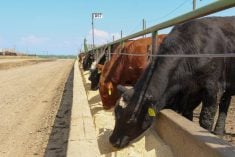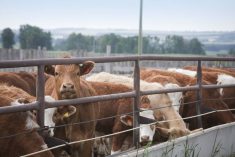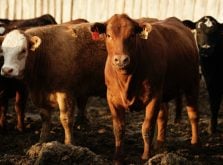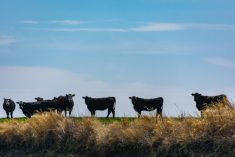The feeder cattle market has experienced extreme volatility over the past three years. For this reason, I’ve been writing on managing financial risk for feeder cattle and particularly for backgrounding operations and cow calf producers. In the first column, I discussed the mechanics of hedging, explained historical basis levels and using these basis levels to forecast an expected price. I also used historical data in Manitoba to analyze the financial returns when backgrounding 550-pound steers and selling them at 850 pounds over the past 10 years.
You may remember that the average return was a meagre $24/head with a standard deviation of $158/head. A producer will either lose $134/head or make $182/head approximately 68.2 per cent of the time. In this series, I want to take this a step further and discuss different hedging strategies and long-run profitability.
Read Also

Harvest wraps up and fall work begins
At the Eppich famly ranch in western Saskatchewan, the fall harvest was successful with few breakdowns, cows and calves have been sorted and a new tractor has arrived
Without any risk management, over the past 10 years if a producer bought 550-pound steers every month and sold them at 850 pounds, the average return was $24/head with a standard deviation of $158/head. What I did next was analyze the average financial return and risk when a producer placed a hedge on every round of feeding. For example, when the producer bought 550-pound feeders, they simultaneously sold feeder cattle futures. In theory, the loss or gain in the cash market would be offset with the loss or gain in the futures market. The result was the average return actually went up to $28 per head and the standard deviation was lowered to $148/head. A producer would have potential to lose $120/head or make $176/head. (The average return of $28/head plus or minus the standard deviation of $148/head.) This situation is a slight improvement from no hedging at all, but still not sufficient to have a serious risk/return on capital.
The next scenario involved buying a put option on the futures market for approximately $25 per head. This would be similar to a producer using the provincially created Livestock Price Insurance Program. In this scenario, the average return dropped to $0 per head. Remember, over the past 10 years with no risk management the average return was $24/head.
In this scenario, the producer is basically using the potential average return for price insurance, so in the long run, the average return is $0 per head. Still no bragging rights and not a logical game plan to encourage any banker to get on board. Using various scenarios on the option, the standard deviation dropped down to a range of about $100 to $150 per head.
In an upward trending market, a $25 option was closer to the futures market, i.e. the deferred futures were trading at a premium to the nearby contract. This makes sense to buy an option. However, when the deferred futures were trading at a discount to the nearby contract, spending $25 on a option was worthless because it was too far out of the money.
There are a few characteristics producers need to know about the feeder market. First, the feeder cattle future is an efficient pure competitive market. If a producer buys feeder cattle when supply and demand are relatively tight and is going to sell when feeder cattle are abundant, then obviously the fundamentals are not favourable. Therefore, you can’t hedge by selling a futures contract or by buying a put option. For example, in the fall of 2015, I had producers call me stating it was going to cost them $80 per head to lock in a $200 loss.
Secondly, in declining markets, the futures market leads the cash price lower so that it is difficult or impossible to hedge a profit or buy price insurance at reasonable levels. Finally, feedlots bid up the price of feeder cattle until there is no margin. If the market turns lower, you won’t be able to hedge at a profit or buy a put option at profitable levels. Feedlots have to experience losses on the current round of feeding before they allow the feeder market to come in line for profitability.
Therefore, I know you’re asking: “What is the key to being successful by decreasing the risk and increasing the return in the long run?” Unfortunately, I’m out of space. In my next article, I’ll take into account all that we’ve learned so far on basis and hedging so that producers can be profitable in the long run and have a reasonable return with the appropriate risk.















